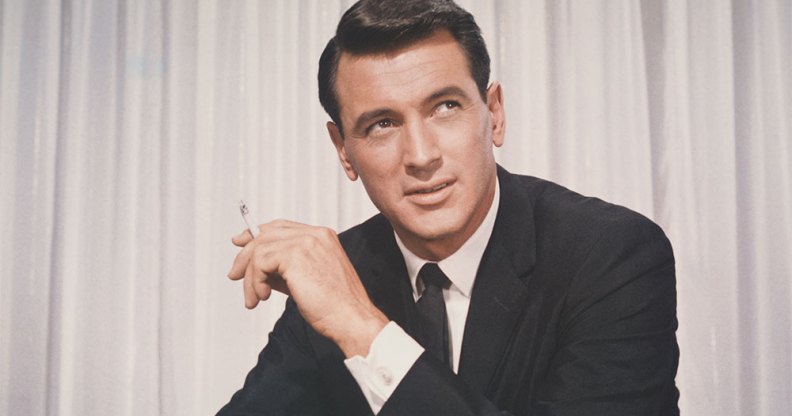Remembering Rock Hudson, Hollywood’s dazzling closeted heartthrob, 35 years since his tragic death from AIDS-related complications

Rock Hudson kept the fact that he was gay secret throughout his life. (Getty)
It is 35 years today since Hollywood’s dazzling closeted heartthrob Rock Hudson died from AIDS-related complications, shocking the world in the process.
At around 9am on 2 October, 1985, Hudson died following months of health complications as a result of his HIV diagnosis. His death shocked the world – and shone a harsh spotlight on the virus that was ravaging the LGBT+ community.
His death came less than three months after his publicist finally confirmed, amid growing speculation, that Hudson had been diagnosed with HIV.
Hudson’s tragic end came after a long, glittering career as one of Hollywood’s dashingly handsome leading men – but his career was marred by dogged rumours about his sexuality from the press.
In 1955, Confidential magazine threatened to publish an exposé revealing Hudson’s sexuality. The story, if published, quite possibly would have destroyed his career when it was just taking off. Hudson’s lecherous agent Henry Willson threw the magazine off the scent by instead releasing personal information about two other clients.
Rock Hudson had a glittering film career before he was diagnosed with HIV in 1984.
The actor was born in Illinois in 1925 and grew up as Roy Harold Scherer Jr, before the world came to know him as Rock Hudson.
After he was discharged from the US Navy in 1946, the then 21-year-old moved to Hollywood with dreams of becoming an actor.
There, he met Willson, an agent known for preying on handsome young men. Willson re-christened him as Rock Hudson – Rock for the rock of Gibralter and Hudson after the river – and his career quickly took off.
But there was a sustained effort behind the scenes to turn Hudson into a leading man – and to rid him of his more effeminate qualities. As depicted in the recent Netflix series Hollywood, Hudson was trained by a vocal coach to speak in a deeper, more “masculine” voice, while Willson would smack his wrists to stiffen them when they fell limply. He would also slap his hips to keep them from swaying.
Hudson had his film debut in 1948’s Fighter Pilot, where he had just one line, and in 1954, he finally achieved leading man status with Magnificent Obsession. The film was a hit – but it prompted an intense focus from the media on the personal life of its star.
In 1955, Life magazine ran a story questioning Hudson’s bachelorhood, with the headline: “Fans are urging 29-year-old Hudson to get married – or explain why not.”
Around the same time, Confidential magazine threatened to out him – and so, a marriage was organised to throw the press off his trail. By the end of 1955, Hudson had married aspiring actor Phyllis Gates.
Within two years, his marriage had begun to fall apart, and the relationship ended in divorce in 1957.
His death helped shine a spotlight on the growing AIDS epidemic.
As the years rolled on, Hudson continued to build his acting career, and he continued appearing in front of the camera right up until June 1984 when he visited a doctor about a sore on his neck. There, he was told the devastating news that he had Kaposi sarcoma, a cancerous tumour that affects people with AIDS.
In July 1985, Hudson joined Doris Day for a press conference in Hollywood where she announced the launch of her new show Doris Day’s Best Friends. But rumours quickly began to swirl about his health after journalists noticed that he appeared gaunt and that his speech was almost incoherent.
Later that month, following initial attempts to downplay Hudson’s illness, a publicist confirmed that he had been diagnosed with HIV. At that time, it was widely believed that HIV only affected the gay community, meaning that Hudson had effectively outed himself as gay.
Hudson died in his sleep on the morning of 2 October, 1985. He was just 59-years-old.
His tragic death inspired an outpouring of grief across Hollywood, and went on to change attitudes towards the AIDS epidemic.
Shortly after his death, People magazine wrote: “Almost overnight, stimulated by massive media coverage, the US came to a consensus: AIDS was a grave danger to the national health, and something had to be done about it – fast.”
Within days of Hudson’s death, Congress announced that it was setting aside $221 million to develop a cure for HIV.
While Hudson’s death will always be remembered as one of the first high-profile tragedies of the AIDS epidemic, it also helped to generate much-needed public support and sympathy as people across the world mourned the loss of a much-loved actor.

